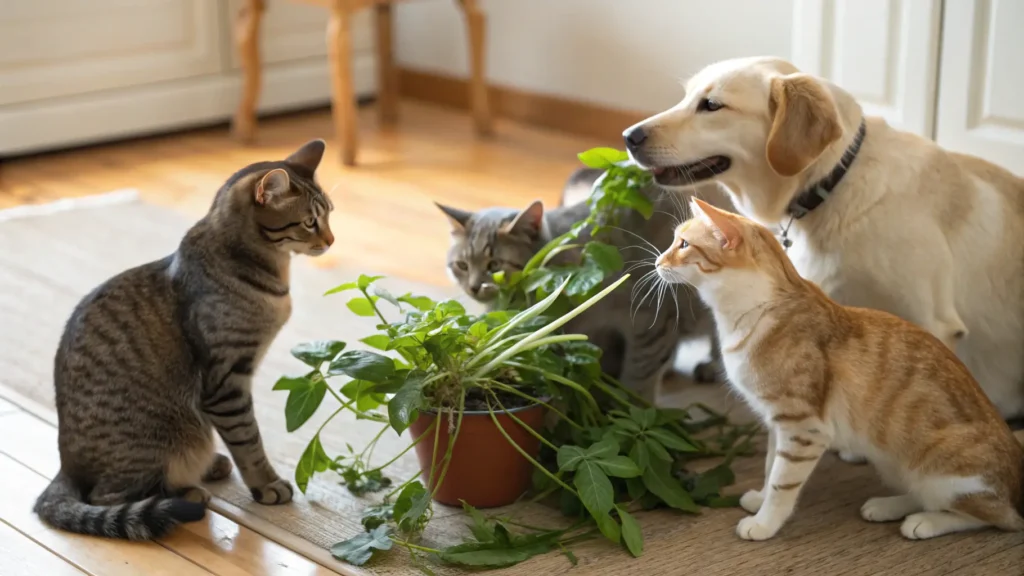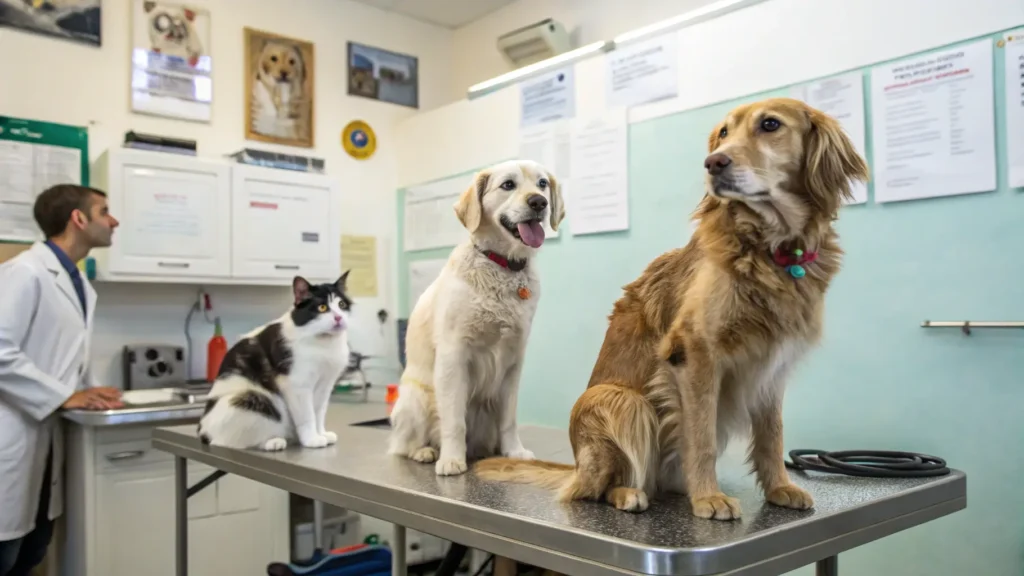Don’t Panic – Your Pet Will Likely Be Okay (But Action is Key)
Discovering your beloved dog or cat munching on a houseplant can trigger instant panic. If that plant happens to be a beautiful prayer plant (Maranta leuconeura), your mind likely races with “Is it poisonous? What do I do now?” Take a deep breath. While prayer plants are considered mildly toxic to pets, they are not life-threatening in most cases. The good news is, serious complications are rare.
This comprehensive, vet-approved guide is designed to transform your worry into clear, actionable steps. You’ll learn exactly what to do if your pet eats a prayer plant, from immediate first aid to understanding when a vet visit is necessary and how to prevent future incidents. Your quick, calm response can make all the difference.
TL;DR: Immediate Actions if Your Pet Eats a Prayer Plant
- Remove & Rinse: Gently remove any plant material from their mouth and offer fresh water to rinse.
- Observe Closely: Watch for common symptoms like drooling, pawing at the mouth, or mild vomiting.
- Call Your Vet: If symptoms are severe, persistent, or you’re simply unsure, contact your veterinarian immediately.
TABLE OF CONTENTS
Are Prayer Plants Truly Toxic to Cats and Dogs? Understanding the Science

The core question every pet owner asks is: “Are prayer plants poisonous?” The answer is nuanced. Prayer plants contain insoluble calcium oxalate crystals, known as raphides. These microscopic, needle-like crystals are the primary cause of irritation if ingested by pets.
When a pet chews on a prayer plant, these tiny crystals are released. They embed themselves in the soft tissues of the mouth, throat, and gastrointestinal tract. This isn’t a systemic poisoning that affects organs, but rather a mechanical irritation. The severity of the reaction depends on the amount ingested and your pet’s individual sensitivity. Most pets experience only mild to moderate discomfort.
Recognizing the Signs: Symptoms Your Pet Might Experience

Knowing what to look for is crucial for assessing your pet’s condition and determining the next steps. Symptoms typically appear quickly, often within minutes to a few hours of ingestion, especially for oral irritation.
Common Symptoms After a Pet Eats a Prayer Plant:
- Oral Irritation:
- Excessive drooling or salivation
- Pawing at the mouth or rubbing face
- Redness or swelling around the lips, tongue, or gums (rarely severe)
- Vocalization (whining) due to discomfort
- Reluctance to eat or drink
- Gastrointestinal Upset:
- Vomiting (can be immediate or delayed)
- Diarrhea (less common, usually mild)
- Loss of appetite or decreased interest in food
- Behavioral Changes (if symptoms are severe or prolonged):
- Lethargy or unusual tiredness
- Restlessness or agitation
Symptom Severity Scale:
Your Step-by-Step Action Plan: What to Do Immediately After Ingestion
If you suspect your pet has eaten a prayer plant, a calm, organized response is best. This step-by-step action plan provides clear guidance.
Step 1: Secure Your Pet & Assess the Situation
First, ensure your pet is in a safe, controlled environment. Gently remove any remaining plant material from their reach and mouth. Try to gather key information:
- Identify the Plant: Confirm it was indeed a prayer plant.
- Approximate Amount: How much did your pet eat? A small nibble vs. a large portion makes a difference.
- Timing: When did the ingestion occur?
- Pet’s Current State: Is your pet bright and alert, or showing any immediate signs of distress?
Step 2: Safe Oral Cleaning & Dilution (Offer Water)
The goal here is to remove as many irritating crystals as possible.
- Remove Visible Bits: Carefully open your pet’s mouth and remove any visible plant pieces. Be gentle to avoid being bitten, especially if they are in discomfort.
- Rinse Mouth (if tolerated): If your pet allows, gently rinse their mouth with cool, clean water. A syringe without a needle can be helpful for this.
- Encourage Drinking: Offer fresh water. Drinking helps dilute the crystals and can provide some relief. Do NOT induce vomiting unless explicitly instructed by a veterinarian, as this can cause further irritation or aspiration.
Step 3: Close Observation & Symptom Tracking
Monitor your pet closely for the next 24 hours. Keep a log of any symptoms, when they started, and how severe they are.
- Watch for: Drooling, pawing at mouth, vomiting, diarrhea, changes in appetite, or lethargy.
- Document: Note the frequency and severity of vomiting or diarrhea. This information is invaluable if you need to call your vet.
- Limit Food (if vomiting): If your pet is actively vomiting, withhold food for a few hours. Once vomiting subsides, offer small amounts of bland food (e.g., plain cooked chicken and rice) to see if they can keep it down. Always consult your vet first if vomiting is severe or persistent.
FOR MORE INFORMATION :
How to Save and Revive a Dying Houseplant
When to Call the Vet: Critical Decision-Making Factors
While prayer plant ingestion is often mild, there are crucial situations where professional veterinary care is essential. Do not hesitate to call your veterinarian or an emergency animal hospital if:
- Persistent or Severe Vomiting/Diarrhea: More than 2-3 episodes of vomiting or diarrhea, or if it contains blood.
- Signs of Significant Pain or Discomfort: Continuous whining, hunched posture, abdominal tenderness.
- Lethargy, Weakness, or Collapse: Your pet seems unusually tired, weak, or collapses.
- Difficulty Breathing or Swallowing: This could indicate severe oral/throat swelling, which is rare but serious.
- Pre-existing Health Conditions: Pets with kidney disease, heart issues, or other chronic illnesses are more vulnerable.
- Very Young (Puppies/Kittens) or Very Old Pets: Their immune systems and resilience are often lower.
- Large Quantities Ingested: If you believe your pet consumed a significant portion of the plant.
- If You Are Unsure or Highly Anxious: Trust your instincts. It’s always better to be safe and get professional advice.
What to Expect at the Vet: From Diagnosis to Recovery
If you decide to take your pet to the vet, knowing what to expect can alleviate some stress. Your vet will conduct a thorough examination and may recommend supportive care.
- Initial Assessment: The vet will perform a physical exam, ask about the plant, the amount ingested, and the symptoms you’ve observed.
- Potential Treatments:
- Oral Rinse/Flushing: Further rinsing of the mouth to remove any remaining crystals.
- Anti-Nausea Medication: To help stop vomiting and make your pet more comfortable.
- GI Protectants: Medications to soothe the stomach lining.
- IV Fluids: If your pet is dehydrated from vomiting or not drinking.
- Pain Management: Though rare for prayer plants, severe oral irritation might warrant mild pain relief.
- Monitoring and Supportive Care: In some cases, your pet might be kept for observation, especially if symptoms are ongoing.
- Prognosis: The prognosis for prayer plant ingestion is generally excellent. Most pets recover fully with no long-term effects, often within 24-48 hours.
“When a pet comes in for prayer plant ingestion, my primary goal is supportive care. We focus on alleviating their discomfort, managing any vomiting, and ensuring they stay hydrated. It’s usually a straightforward case, and owners are relieved to learn it’s rarely life-threatening.” – Dr. Sarah Green, DVM.
Preventing Future Incidents: Pet-Proofing & Safer Plant Choices
Prevention is always the best approach. By pet-proofing your home and choosing safe alternatives, you can ensure your furry friends and your foliage coexist happily.
- Strategic Plant Placement: Place all houseplants, especially prayer plants, in areas completely out of reach. Think high shelves, hanging baskets, or rooms that pets can’t access.
- Physical Barriers: Use pet gates to block off specific rooms or areas where plants are kept. Consider decorative cages around larger plants.
- Pet Deterrents: Bitter apple sprays or citrus peels can deter some pets from chewing. Sprinkle cayenne pepper (sparingly, as it can cause irritation) or cover soil with decorative stones to prevent digging.
- Training & Redirection: Teach your pet the “leave it” command. Provide plenty of appropriate chew toys and enrichment to redirect their attention away from plants.
- Regular Supervision: Always supervise your pet, especially young puppies and kittens, who are naturally curious.
Top Pet-Safe Houseplant Alternatives
To broaden your green thumb horizons without worry, consider these beautiful and non-toxic options:
- *African Violet (*Saintpaulia spp.*)*
- Christmas Cactus (*Schlumbergera bridgesii*)
- *Boston Fern (*Nephrolepis exaltata ‘Bostoniensis’*)*
- *Haworthia (*Haworthia spp.*)*
- *Orchids (*Phalaenopsis spp.*)*
- Parlor Palm (*Chamaedorea elegans*)
- Polka Dot Plant (*Hypoestes phyllostachya*)
- Spider Plant (*Chlorophytum comosum*) (A fantastic choice, easy to grow!)
- Friendship Plant (*Pilea involucrata*)
- Money Tree (*Pachira aquatica*)
Frequently Asked Questions About Prayer Plants and Pet Safety
Is a small bite of a prayer plant dangerous for my pet?
A small bite typically causes only mild, localized oral irritation. While uncomfortable, it is unlikely to lead to serious health issues. Always monitor for symptoms.
Can prayer plants cause long-term damage to my pet?
No, prayer plant ingestion usually does not cause long-term damage. The effects are generally temporary and resolve within a day or two with supportive care or by simply diluting the irritants.
What if my pet eats a lot of prayer plant?
Ingesting a large quantity increases the likelihood and severity of symptoms like vomiting and oral discomfort. While still not usually life-threatening, it warrants a call to your veterinarian for advice and possible treatment.
Are other common houseplants also toxic?
Yes, many common houseplants are toxic to pets. It’s crucial to research each plant. Some highly toxic plants include lilies (especially to cats), sago palms, oleander, and azaleas. Always check reputable sources like the ASPCA.
FOR MORE INFORMATION : Poisonous Plants
How do I know if it’s really a prayer plant? (Identification tips)
Prayer plants are known for their distinctive oval leaves with decorative patterns (often red, green, and cream veins) and their habit of folding their leaves upwards at night, resembling hands in prayer. If unsure, compare your plant to online images or consult a plant identification app.
Conclusion
Finding your pet sampling your prayer plant can be startling, but remember that these beautiful plants cause only mild irritation, not life-threatening poisoning, in most cases. By following this vet-approved, step-by-step guide, you’re empowered to take immediate, effective action. Focus on removing plant material, offering water, and closely observing for symptoms.
